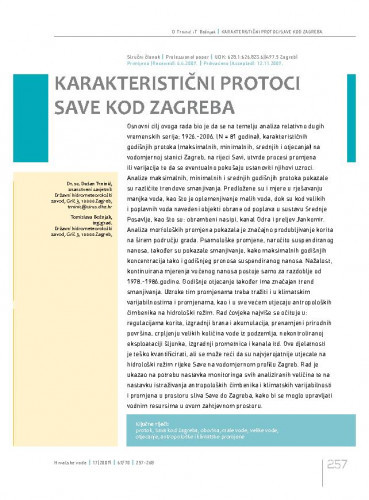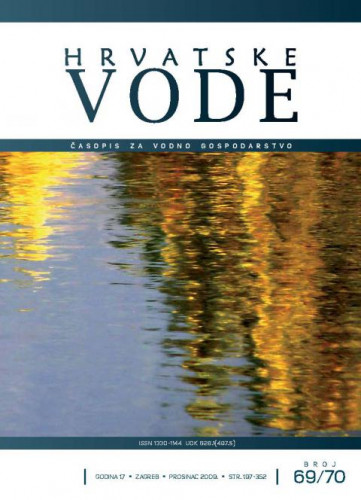Osnovni cilj ovoga rada bio je da se na temelju analiza relativno dugih vremenskih serija: 1926.-2006.(N = 81 godina), karakterističnih godišnjih protoka (maksimalnih, minimalnih, srednjih i otjecanja) na vodomjernoj stanici Zagreb na rijeci Savi, utvrde procesi promjena ili varijacija, te da se eventualno pokušaju ustanoviti njihovi uzroci. Analize maksimalnih, minimalnih i srednjih godišnjih protoka pokazale su različite trendove smanjivanja. Predložene su i mjere u rješavanju manjka voda, kao što je oplemenjivanje malih voda, dok su kod velikih i poplavnih voda navedeni objekti obrane od poplava u sustavu Srednje Posavlje, kao što su: obrambeni nasipi, kanal Odra i preljev Jankomir. Analiza morfoloških promjena pokazala je značajno produbljivanje korita na širem području grada. Psamološke promjene, naročito suspendiranog nanosa, također su pokazale smanjivanje kako maksimalnih godišnjih koncentracija tako i godišnjeg pronosa suspendiranog nanosa. Nažalost, kontinuirana mjerenja vučenog nanosa postoje samo za razdoblje: 1978.-1986.godina. Godišnje otjecanje također ima značajan trend smanjivanja. Uzroke tim promjenama treba tražiti i u klimatskim varijabilnostima i promjenama, kao i u sve većem utjecaju antropoloških čimbenika na hidrološki režim. Rad čovjeka najviše se očituje u: regulacijama korita, izgradnji brana i akumulacija, prenamjeni prirodnih površina, crpljenju velikih količina vode iz podzemlja, nekontroliranoj eksploataciji šljunka, izgradnji prometnica i kanala itd. Ove dijelatnosti je teško kvantificirati, ali se može reći da su najvjerojatnije utjecale na hidrološki režim rijeke Save na vodomjernom profilu Zagreb. Rad je ukazao na potrebu nastavka monitoringa svih analiziranih veličina, te na nastavku istraživanja antropoloških čimbenika i klimatskih varijabilnosti i promjena u prostoru sliva Save do Zagreba, kako bi se moglo upravljati vodnim resursima u ovom, zahtjevnom prostoru..; The primary objective of the paper was to determine, based on the analyses of a relatively long time series, i.e. 1926-2006 (N = 81 years), characteristic annual discharges (maximum, minimum, mean and runoff) at the water gauging station Zagreb on the Sava river the processes of changes or variations and possibly attempt to determine their causes. The analyses of maximum, minimum and mean annual discharges show different trends of decrease. Measures were proposed to solve water deficit, such as improvement of low water levels. At high water levels or floods, there are flood protection facilities in the Central Sava system, such as dikes, the Odra canal and the Jankomir overflow. The analysis of morphological changes showed a significant deepening of the river bed in the greater Zagreb area. Psamological changes, particularly after suspended sediment, also showed a decrease in maximum annual concentrations and annual transfer of suspended sediment. Unfortunately, continuous measurements of bed load exist only for the period 1978-1986. Annual runoff also has a significant trend of decrease. The causes of these changes should also be sought in climate variations and changes as well as in the ever-increasing influence of anthropological impacts on the hydrological regime. The human impact can be mostly seen in the works such as river bed regulation, construction of dams and reservoirs, changed use of natural areas, abstraction of large water quantities from the underground, uncontrolled gravel exploitation, construction of roads and canals, etc. These activities are difficult to quantify, but it can be stated that they most probably had an influence on the hydrological regime of the Sava at the water gauging station Zagreb. The paper indicates that there is a continuing need for monitoring of all analyzed phenomena as well as continued investigation of anthropological factors and climate variations and changes in the Sava river basin up to Zagreb for purposes of controlling the water resources in this demanding area.
Sažetak
Dio sveska

